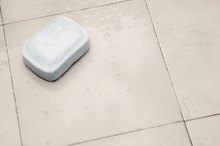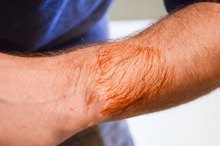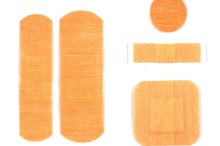What does fact checked mean?
At Healthfully, we strive to deliver objective content that is accurate and up-to-date. Our team periodically reviews articles in order to ensure content quality. The sources cited below consist of evidence from peer-reviewed journals, prominent medical organizations, academic associations, and government data.
The information contained on this site is for informational purposes only, and should not be used as a substitute for the advice of a professional health care provider. Please check with the appropriate physician regarding health questions and concerns. Although we strive to deliver accurate and up-to-date information, no guarantee to that effect is made.
Dermabond Complications
Dermabond is a skin adhesive used to close wounds, according to FamilyDoctor.org 2. It is a liquid that doctors apply on small wounds and skin surfaces to securely hold the edges together. Once applied, this film is left to dry and usually lasts five to 10 days on the skin. Dermabond is not used on areas such as the eyes and mouth. Though it keeps the wound clean, dry and intact, there are some complications associated with Dermabond.
Wound Dehiscence
Wound dehiscence, a condition in which a wound, usually from a surgical site, breaks open, is one of the possible complications of Dermabond usage, according to the American Academy of Family Physicians. This condition is caused by straining, physical stress on the affected area and poor blood circulation. Sutures may be required to repair the open wound.
Skin Infection
Care of Skin After Cryosurgery
Learn More
According to the American Academy of Family Physicians, skin infection can occur as a complication for using Dermabond 2. With the application of this liquid skin adhesive, adequate cleansing and wound preparation is essential. This helps prevent opportunistic bacteria from infecting the wound and potentially spreading to surrounding tissues. Minor skin infections are usually treated with oral antibiotics.
- According to the American Academy of Family Physicians, skin infection can occur as a complication for using Dermabond 2.
Hypersensitivity Reactions
As noted by MedlinePlus, hypersensitivity reactions is a possible Dermabond complication. An allergic reaction characterized by skin rashes, itching and swelling happens when the immune system reacts to a certain substance. Some patients are allergic to cyanoacetate and formaldehyde which are the main components of Dermabond.
Run-off to Other Areas
How to Remove Betadine Stains From Skin
Learn More
Application of Dermabond can cause run-offs to other areas near the wound being treated, as described by the American Academy of Family Physicians. Dermabond dries quickly, in as short as 10 seconds, but when it adheres to areas that are not supposed to be glued, it is problematic. This excess adhesive can be wiped off directly using cotton balls, dry gauze or even a clean finger.
Repeat Trauma
Repeat trauma to the wound is one of the possible complications of Dermabond usage, according to MedlinePlus. Patients who pick their wounds excessively can re-open the wound and cause another breakage or trauma. These wounds can be closed for the second time using sutures or skin adhesives.
Related Articles
References
- FamilyDoctor.org: First Aid – Cuts, Scrapes and Stitches
- American Family Physician: Using Tissue Adhesive for Wound Repair: A Practical Guide to Dermabond
- 3M Wound Resource Center. http://solutions.3m.co.uk/wps/portal/3M/en_GB/skin-care/wound-resource-centre/
- Mccaughan D, Sheard L, Cullum N, Dumville J, Chetter I. Patients' perceptions and experiences of living with a surgical wound healing by secondary intention: A qualitative study. Int J Nurs Stud. 2018;77:29-38. doi:10.1016/j.ijnurstu.2017.09.015
- Krafts KP. Tissue repair: The hidden drama. Organogenesis. 2010;6(4):225-33. doi:10.4161/org.6.4.12555
- Chetter IC, Oswald AV, Fletcher M, Dumville JC, Cullum NA. A survey of patients with surgical wounds healing by secondary intention; an assessment of prevalence, aetiology, duration and management. J Tissue Viability. 2017;26(2):103-107. doi:10.1016/j.jtv.2016.12.004
- Singh PK, Saxena N, Poddar D, et al. Comparative Study Of Wound Healing In Primary Versus Delayed Primary Closure In Contaminated Abdominal Surgery. Hellenic J Surg. 2016;88:314–320. doi:10.1007/s13126-016-0340-8
- Surgical Patient Education Program: Prepare for the Best Recovery. American College of Surgeons. 2018.
- Rushbrook JL, White G, Kidger L, Marsh P, Taggart TF. The antibacterial effect of 2-octyl cyanoacrylate (Dermabond®) skin adhesive. J Infect Prev. 2014;15(6):236-239. doi:10.1177/1757177414551562
- Lazar HL, Mccann J, Fitzgerald CA, Cabral HJ. Adhesive strips versus subcuticular suture for mediansternotomy wound closure. J Card Surg. 2011;26(4):344-7. doi:10.1111/j.1540-8191.2011.01257.x
- 3M Wound Resource Center.
Writer Bio
Helen Nnama has six years of writing experience. She is a health contributor to TBR Journal, editor of fertility confidential manuals, published poet, and a greeting card writer. She has a B.S. in microbiology, an M.S. in epidemiology, and is an M.D. candidate. A former state HIV/AIDS epidemiologist and NIA fellow at Johns Hopkins, she has research experience with published work.









